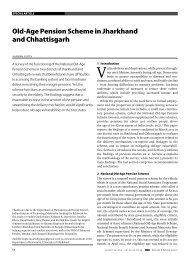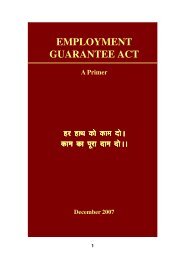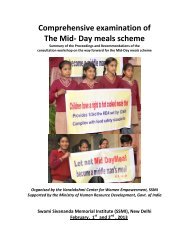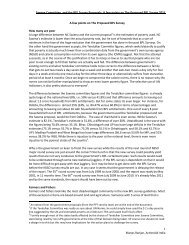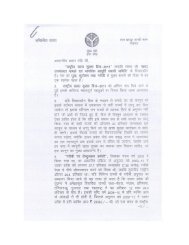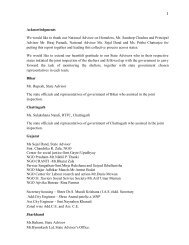NREGA: Opportunities and Challenges - Diksha
NREGA: Opportunities and Challenges - Diksha
NREGA: Opportunities and Challenges - Diksha
You also want an ePaper? Increase the reach of your titles
YUMPU automatically turns print PDFs into web optimized ePapers that Google loves.
<strong>NREGA</strong>: OPPORTUNITIES AND CHALLENGESInstead of implementing <strong>and</strong> evaluating the act purely in terms of employment creation, the focus shouldbe on real impacts on local development through productive assets creation. Currently, the Union ministryof rural development evaluates the act on job creation <strong>and</strong> the number of assets created under preferredworks category. The real effectiveness of the scheme can be measured by using three parameters:1. Increase in average annual income of households2. Increase in the productivity of small <strong>and</strong> marginal l<strong>and</strong> holdings3. Quality <strong>and</strong> contribution of assets like water tanks to overall water availability <strong>and</strong> groundwaterrecharge etc.By changing the evaluation parameters as suggested, the scheme will assume the character of a ruraldevelopment scheme, instead of a run-of-the-mill wage-earning programme. This will also help thegovernment ensure that most of the works taken up remain within the preferred works category, that is,productive assets.2. Make wage payment people- <strong>and</strong> development-friendly. Instead of convoluted wagecalculations, which defeat the very aim of the programme, make payment of wages forwork done simple <strong>and</strong> hassle-free. Provide a premium wage fordevelopment programmes, which will ensure that work done iscompleted <strong>and</strong> is usefulThe government should set a Irregular payments, <strong>and</strong> paying less than the daily minimum wage, haveturned out to be two great threats to the act’s development potential. Theminimum number of water <strong>NREGA</strong> guarantees employment, not wages, so argue governments. Digginga tank, which requires more labour from a person, fetches less money – allconservation works to be because of the government’s archaic wage rates based on finished tasks.undertaken using the <strong>NREGA</strong>funds. Or it can incentivisethis through its guidelines –pay higher wages for waterrelated works. We wouldprefer the latterprovide long-term relief.On the other h<strong>and</strong>, building a road fetches more money, <strong>and</strong> requires lesslabour. Usually, a person working on a water harvesting structure gets lessthan 40 per cent of the wage he or she would have earned working on roadconstruction. The result: roads <strong>and</strong> buildings are in. In many villages,panchayats are reluctantly approving road construction even though thereare dem<strong>and</strong>s for or requirement of water harvesting structures.States like Andhra Pradesh <strong>and</strong> Gujarat have rationalised their wagecalculation methods to incentivise creation of productive assets. In MadhyaPradesh, the government has raised the wage money for digging a well tobring it at par with that for road construction. But most other states havenot adapted such measures. In fact, development programmes must bepaid on a premium basis – higher than minimum wages for works, whichThe payment of wages for work done in the <strong>NREGA</strong> must be rationalized <strong>and</strong> simplified. The act hasprovisions, which specify that people working under <strong>NREGA</strong> must be given the basic minimum daily wage,irrespective of the methods used to measure the works finished. In addition, the Act also supports thecreation of durable assets. These provisions need to be highlighted <strong>and</strong> made clearer in fresh guidelines.3. Emphasis on centrality of water conservation in <strong>NREGA</strong> by measuring its effectivenessDespite the ‘non-negotiable’ nature of productive assets creation under the <strong>NREGA</strong>, most states haveresorted to their own ways <strong>and</strong> means of spending the <strong>NREGA</strong>. Only five states have made substantialallocation to water conservation. During 2006-07, Andhra Pradesh alone accounted for about 67 per centof the total water conservation works under <strong>NREGA</strong> in the country. In the same period, Uttar Pradesh,Orissa, Assam <strong>and</strong> Bihar devoted more money to road connectivity works than to water conservation.This needs to change. Water conservation, the bulwark of rural development, must be made the mainstayof <strong>NREGA</strong>. Most of <strong>NREGA</strong> districts are in dryl<strong>and</strong> areas <strong>and</strong> groundwater is a critical resource foragriculture. Thus the <strong>NREGA</strong> should focus on water conservation <strong>and</strong> recharge of groundwater. In fact, all56



